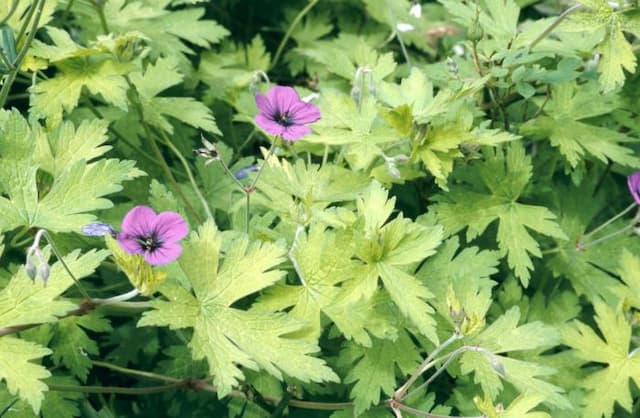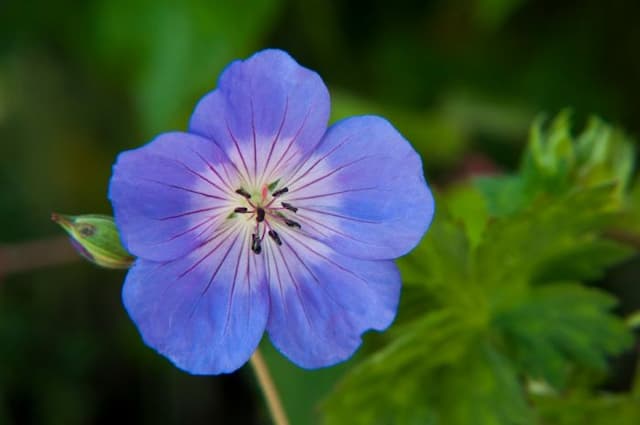Cranesbill Geranium wallichianum Havana Blues = 'Noorthava' (PBR)
![cranesbill [Havana Blues]](/_next/image?url=https%3A%2F%2Fplants-admin.emdemapps.com%2Fimages%2Fplants%2F%2Fimages%2F604b555f9f493.png&w=3840&q=75)
ABOUT
Geranium Havana Blues, commonly known as the Havana Blues hardy geranium or cranesbill, is a flowering plant known for its ornamental appeal. This cultivar boasts distinctive lush foliage with deeply lobed leaves that exhibit an attractive, fresh green color. As the common name cranesbill suggests, this plant comes from a genus where the fruit capsule often resembles the bill of a crane. The blossoms of Havana Blues are particularly striking. Each flower is composed of a set of delicate petals that converge to form a bloom that radiates shades of blue-violet, creating a soothing and cool color palette in the garden. The petals may display prominent veining or slight gradations of color, adding depth and visual interest to the overall appearance of the flower. These blooms are set against the verdant leaves, with the contrast highlighting the flowers' vibrant hue. Throughout the blooming season, which generally spans from late spring into the early summer months and sometimes into autumn, Geranium Havana Blues presents a profusion of these appealing flowers. The blooms can attract various pollinators such as bees, enhancing the plant's role as not only an ornamental feature but also as a contributor to the garden's biodiversity. It is also worth noting that this plant typically has a mound-forming habit, which means it can create a neat, rounded presence in the landscape. Its growth pattern and the abundance of both foliage and flowers contribute to its use as a ground cover, border plant, or as a complement to other plants in mixed garden beds. Overall, the Geranium Havana Blues combines the characteristics of robust, lovely foliage with distinctive blue-violet flowers to offer gardeners a visually striking and adaptable plant that enhances the beauty of various garden settings.
About this plant
 Names
NamesFamily
Geraniaceae
Synonyms
Wallich's Cranesbill, Himalayan Geranium, Havana Blues Geranium
Common names
Geranium wallichianum Havana Blues = 'Noorthava' (PBR)
 Toxicity
ToxicityTo humans
Geraniums, commonly known as cranesbills, including Geranium wallichianum 'Havana Blues', are not considered toxic to humans. They are generally safe when touched or ingested in small quantities. Therefore, accidental ingestion of this plant is unlikely to cause any symptoms of poisoning or serious consequences. However, it's always best to avoid ingesting plants that are not specifically intended for consumption as individual allergic reactions or sensitivities could occur.
To pets
Cranesbills, including Geranium wallichianum 'Havana Blues', are not known to be toxic to pets. This plant, like many geraniums, is typically safe around animals and is not expected to cause any symptoms of poisoning if a pet nibbles on the leaves or flowers. However, ingestion of any plant material can potentially cause mild gastrointestinal upset in sensitive pets, such as vomiting or diarrhea, so it's wise to prevent pets from eating large amounts of any non-food plants.
 Characteristics
CharacteristicsLife cycle
Perennials
Foliage type
Deciduous
Color of leaves
Green
Flower color
Blue
Height
1-2 feet (30-60 cm)
Spread
1-2 feet (30-60 cm)
Plant type
Herb
Hardiness zones
5
Native area
Himalayas
Benefits
 General Benefits
General Benefits- Aesthetic Appeal: Adds vibrant blue-purple blooms to gardens and landscapes.
- Attracts Pollinators: Flowers attract bees and butterflies, supporting local ecosystems.
- Low Maintenance: Requires minimal care once established, making it suitable for novice gardeners.
- Drought Tolerance: Once established, it can tolerate periods of drought, reducing the need for frequent watering.
- Long Blooming Season: Offers a lengthy display of flowers from spring to fall.
- Cold Hardy: Capable of surviving in cooler climates, making it a versatile choice for various garden zones.
- Versatility: Can be used in borders, containers, and rock gardens, providing numerous landscaping options.
- Deer Resistance: Typically not favored by deer, which reduces the risk of damage from wildlife.
- Rapid Growth: Quickly reaches full size, allowing for fast establishment in the garden.
 Medical Properties
Medical PropertiesThis plant is not used for medical purposes.
 Air-purifying Qualities
Air-purifying QualitiesThis plant is not specifically known for air purifying qualities.
 Other Uses
Other Uses- Insect Deterrent: The plant may be used in gardens to help deter certain types of insects due to its scent, which is not favored by some insect species.
- Natural Fabric Dye: The petals and leaves can be used to create a natural dye for fabrics, offering a range of colors depending on the mordant used.
- Garden Borders: Its compact growth habit makes it ideal for creating attractive borders along garden walkways or edges.
- Artistic Inspiration: The vibrant colors and unique form of the 'Havana Blues' can serve as an inspiration for artists and photographers.
- Floral Arrangements: It can be used in fresh or dried floral arrangements to add a splash of color and texture to bouquets.
- Educational Resource: The plant could be used in schools or educational programs to teach students about plant growth, reproduction, and horticulture.
- Culinary Garnish: Edible varieties of geranium can be used as a colorful, aromatic garnish in culinary dishes, though one should verify edibility before use.
- Attracting Pollinators: It can be planted to attract bees, butterflies, and other beneficial pollinators, thereby supporting local ecosystems.
- Craft Projects: Dried leaves and flowers can be used in various craft projects, such as potpourri, sachets, or embedded in candles.
- Seasonal Decor: Its blue hues can complement seasonal decor, particularly in spring and summer themed displays or events.
Interesting Facts
 Feng Shui
Feng ShuiThe Geranium is not used in Feng Shui practice.
 Zodiac Sign Compitability
Zodiac Sign CompitabilityThe Geranium is not used in astrology practice.
 Plant Symbolism
Plant Symbolism- Unity and Friendship: Geraniums, in general, are often associated with unity and friendship due to their clustering blossoms which represent people coming together.
- Good Health: Traditionally, geraniums are believed to promote good health, symbolizing a wish for the well-being of the recipient.
- Positive Emotions: The bright and vibrant colors of the Geranium Havana Blues can symbolize happiness and a positive outlook on life.
- Peace: Geraniums are sometimes associated with peace and tranquility, making them a suitable gift for someone seeking calm in their life.
 Water
WaterCranesbill geraniums, such as 'Havana Blues', require regular watering to keep the soil evenly moist but not waterlogged. Water deeply once a week, providing about one gallon of water for each plant, to encourage deep root growth. During peak summer heat or in particularly dry climates, you might need to increase watering frequency to every 3 to 4 days. Always check the top inch of soil for dryness before watering to avoid overwatering. Reduce watering during the fall and winter months when the plant is not actively growing.
 Light
LightCranesbill geraniums thrive best in full sun to partial shade. They prefer a spot that receives at least 4 to 6 hours of sunlight each day but can benefit from some afternoon shade in hotter climates to prevent scorching. East or west-facing gardens are ideal to provide the perfect balance of light and protection.
 Temperature
TemperatureCranesbill geraniums are hardy plants that can tolerate a wide range of temperatures. They grow best in conditions between 60 and 75 degrees Fahrenheit but can withstand temperatures as low as 20 degrees Fahrenheit during their dormant winter phase. However, prolonged exposure to temperatures above 85 degrees Fahrenheit may stress the plant.
 Pruning
PruningCranesbill geraniums benefit from occasional pruning to remove spent flowers and encourage bushier growth. Prune lightly throughout the growing season to deadhead and promote continuous blooming. In late fall or early spring, cut back the entire plant to about 4 to 6 inches from the ground to help rejuvenate it and maintain a compact shape. This timing allows the plant to focus on healthy new growth as the season progresses.
 Cleaning
CleaningAs needed
 Soil
SoilHardy Geranium Havana Blues thrives in well-draining soil that is rich in organic matter with a slightly acidic to neutral pH of around 5.8 to 7.2. A good mix can be made by combining garden soil with compost and perlite to improve drainage. Ensure the soil mix is kept moist but not waterlogged to promote healthy growth.
 Repotting
RepottingHardy Geranium Havana Blues should be repotted every 2 to 3 years or when you notice the roots are crowded. Choose a container only slightly larger than the previous one as geraniums tend to bloom better when somewhat root-bound.
 Humidity & Misting
Humidity & MistingHardy Geranium Havana Blues prefers average room humidity levels. It doesn’t require high humidity, making it suitable for typical home environments.
 Suitable locations
Suitable locationsIndoor
Grow in bright, indirect light and well-draining soil mix.
Outdoor
Plant in part sun, amend soil with organic matter, water moderately.
Hardiness zone
5-9 USDA
 Life cycle
Life cycleGeranium Havana Blues begins its life cycle as a seed which, once sown, germinates and develops into a seedling. From there, the plant enters the vegetative stage, where it grows leaves and stems, typically forming a low-growing mound of foliage. As it matures, the plant enters the flowering stage, producing distinctive blue flowers that attract pollinators and can add ornamental value from late spring to early autumn. After pollination, the flowers develop into fruit capsules, each of which contains seeds that are dispersed when the capsules ripen and split open. The plant may die back to the ground in winter, especially in cooler climates, but it is generally a perennial, so it will enter dormancy only to regrow from its rootstock when conditions become favorable in the spring. Throughout its life, Geranium Havana Blues will continue to grow and spread, often through self-sowing or vegetative propagation if conditions are suitable.
 Propogation
PropogationPropogation time
Spring to Summer
Geranium Havana Blues, commonly known as Cranesbill, is most popularly propagated through division, which is best done in early spring or autumn. To propagate by division, carefully dig up the entire plant, making sure to keep a good amount of the root system intact. Using a sharp spade or knife, divide the plant into smaller sections, each with at least one shoot and a portion of the root system. Replant the divisions promptly, spacing them about 12 inches (30 centimeters) apart to give them plenty of room to grow. Water the new plants thoroughly to help establish them, and maintain consistently moist soil as they take root and begin to grow in their new locations.









